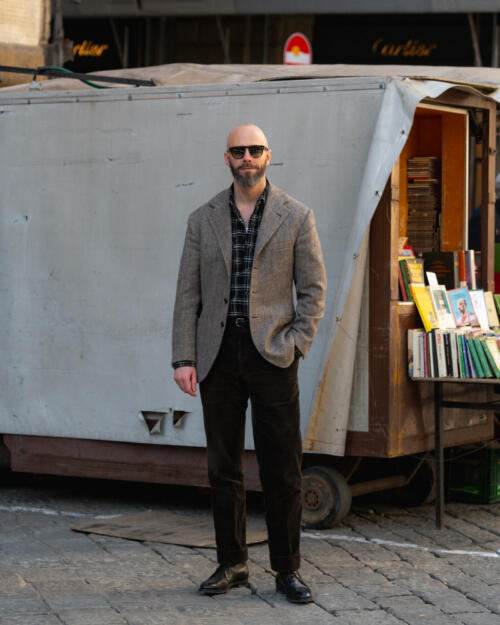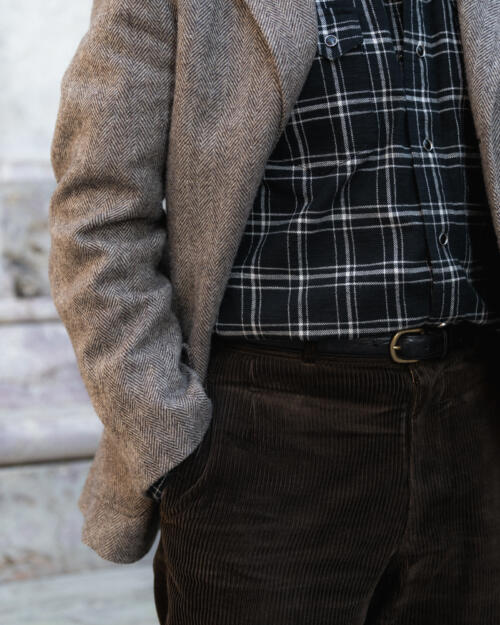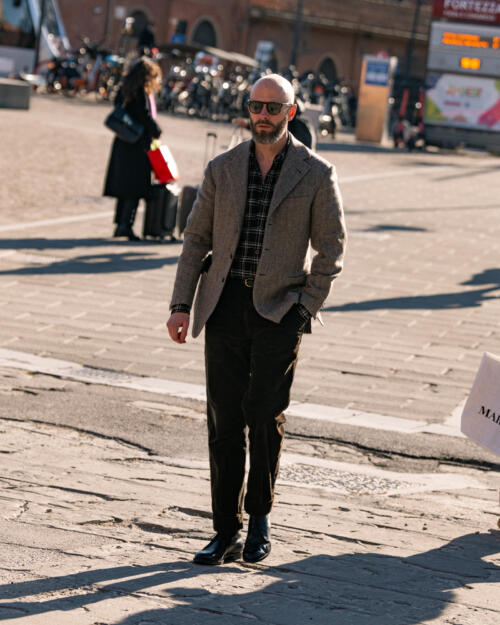A friend referred to this outfit as ‘dark Ivy’ recently, and I liked the idea. Traditional Ivy style has much to recommend it today, particularly the way it mixes sportswear and tailoring together. I set out the ways I like that attitude in this post a couple of years ago.
But one of its weaknesses is that it doesn’t seem that urban, or is a little too bright and playful for some people. Taking Ivy-type clothes and rendering them in darker, more subdued colours is an interesting way to spin that classic American aesthetic.
You could think of it as a cold-colour wardrobe version of Ivy.

The combination I’m wearing here, comprising a herringbone tweed jacket, checked flannel shirt and corduroy trousers, is pretty Ivy.
But the colours are rather different. The tweed is low contrast and muddy, unlike a more traditional grey herringbone such as my Anthology jacket here. The flannel shirt is black and white, and mostly black at that. And the cords are a dark cold brown, unlike the warm browns or tans and bottle greens you’d get at a J Press in the US or, here in the UK, Cordings.
The accessories and shoes are dark or black too, which is not what you’d expect. The Ivy or English rural wardrobe is more commonly mixed with snuff and mid-brown leather, and accessories in bright colours that pop.
I hesitate to call this look ‘cool’ because that’s so subjective, and because I’d shrink from ever calling myself that. But it’s certainly more city, less country, in its dark and lower contrast combinations.

Another thing this type of look sometimes gets called is the ‘geography teacher’ look. The subject varies depending where you are, and sometimes the teacher becomes a professor, but the aesthetic is the same: corduroy, tweed, knitted ties and so on.
There’s a reason this type of profession is associated with this type of look of course: teachers usually want to indicate a little bit of authority in the way they dress, but they don’t want to wear a business suit. The next level down is shirts and tailoring, but in non-business materials.
For the rest of us, it’s a good reference for one way to dress up without wearing a suit, in much the same way as the ‘casual chic’ look. And it’s not hard to do, given all that really changes is the colour palette.

Emilie Hawtin also referred to something similar to this in her article for us last year, called the shoe selection ‘goth prep’. For her, taking “East-Coast traditional” pieces and having them in black suggested a hint of rebellion.
I wouldn’t go that far with my outfits, but I see what she’s getting at. There is something a little edgier in the use of black, but particularly when the flannel shirt has western details like the black snaps of my Bryceland’s, or the sunglasses are slightly more unusual and angular, like these from L’Ingenieur Chevallier.
That Bryceland’s shirt has a fantastic handle by the way, and I’m glad they did a flannel one in a colour I’d wear. I was afraid the strong pattern would be too much on me, but it’s proving pretty wearable. I was a little unsure about the western details too – the curved yoke on the back on top of that check for example – but the pattern actually subdues a lot of it.
The fit is the same as the other sawtooth westerners by the way, so a little slim and there is some shrinkage. I went for a size 42, like my sawtooth, which is a size up from normal. This works really well on me, unlike the similar half-zip shirt, which is too full in the body.

Elsewhere in the outfit, those are the brown-cord trousers from my Sartoria Ciardi suit. My super-heavy Brisbane Moss ones might have been even nicer, but those don’t have belt loops and the belt helps the outfit here I think. Maybe time to add belt loops to those.
The jacket is my Sartoria Salino from Florence, which has been slimmed down a little since first reviewed on PS, and is just perfect now. A really well-fitted example of Florentine tailoring.
The belt is from Rubato, the hat from PS, and the vest from Buck Mason. Like other outfits we’ve talked about recently, that little glimpse of white is a nice touch I find, giving a little focus to the top half.
The shoes are Shanklins from Edward Green, unlined in their black ‘Arno’ leather. That leather looks really dull when you get it, but a little cream (not polish) goes a long way to giving it a nice glow.
The chain is a gold one I’ve had for a few years – a present from my wife. I’ll do a separate post on it at some point as a few readers have expressed interest.

